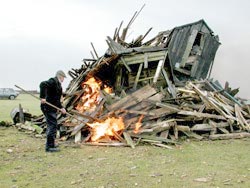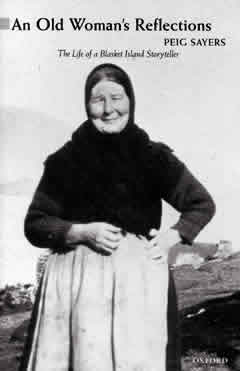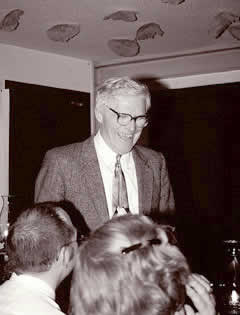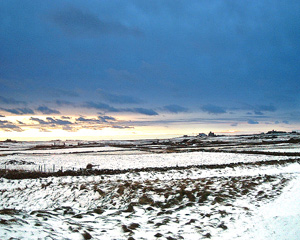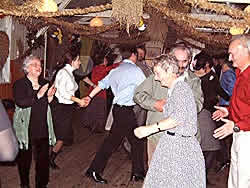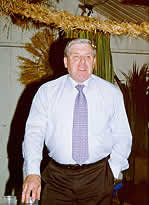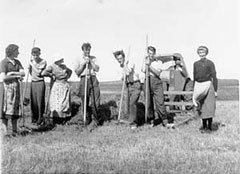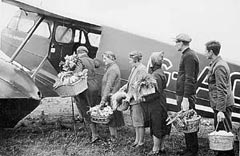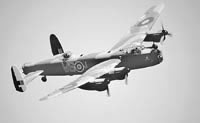In one of our attics, which is full of 101 items of as wide a range of subject matter as one could ever imagine, and covering many years of accumulation, one day, some time ago, I came across a little red Boys’ Brigade Diary for 1954. The Boys’ Brigade was an organisation with which I was involved for a time – but more of this later. The contents of my diary, which include entries for Christmas Day 1953 and that year’s Hogmanay, are short and simple, but nevertheless they give a brief account of those times when I was mainly living in Kirkwall – plus bits and pieces related to North Ronaldsay and like diaries do, they stimulate the memory and take one back in time.
Well, I always planned to try and put something together which uses the diary as a sort of memory stepping stone. So here at last I am sitting down at my computer intending to tell you a little about those times.
I suppose I should begin at the beginning and go back to the year of 1952 when I, and some others of my generation, first left North Ronaldsay to attend the Kirkwall Grammar School. A few, a bit older, were already there, or in Sanday and Finstown, and yet others were further afield – at Universities, Colleges, and so on – they usually left for their venues later than the standard school-time. However, that year, at the end of the summer holidays, we left the island by Post Boat, being rowed out in a small praam to this boat. During good weather in the summer time, the Post Boat was sometimes moored out at sea a little distance from the land at Bridesness – an area from which island fishing-boats worked. This was the only time we sailed from that location that I remember – all other times were from the pier. When leaving for a new school term or coming home on holiday, we had to frequently embark or disembark in swells which rose and fell by many feet. And sometimes when we arrived at the pier, home on holiday, we had to help ‘wap’ the boat up by hand-operated crane from the sea on to the pier, and then on to a cradle to be again ‘wapped’ to the safety of the boat-noust.
In the early days there were no cars to take us home; generally, to keep our clothes clean,we sat on old sacks, which would be spread on a ‘bogie’, linkbox, or maybe a little cart, drawn by tractor. In those days Johnny o’ North Ness (John Tulloch) was the boatman in charge. He was indeed a man of the sea, aged at that time 55, and responsible for carrying the Royal Mail between Sanday and North Ronaldsay. Earlier, in 1939, during a difficult and dangerous rescue of a number of the crew of the Mim (a Norwegian cargo vessel) which had struck the reef dyke – a submerged reef lying about a mile distant from the island, the captain of the ship, seeing the rescue at first hand, was said to have described John Tulloch as “a boatman in a thousand”. A Naval Prize crew, who were on board the Mim, were also highly impressed by his seamanship – but this is another story.
Let me depart here for a moment from my first Post Boat trip to give you some idea of what travellers had to frequently endure when communications depended entirely on the sea connection. It was not unusual to wait for a day or two in Kirkwall for suitable weather conditions when we were on our way home at the end of each school term. There were numerous rough trips from Kirkwall when sometimes the ship had to turn back well into her passage – even on occasion from the very pier in North Ronaldsay, without landing passengers or cargo and having then to return to Kirkwall – a journey which could take four hours or more in adverse conditions; of being weather-bound in Sanday and waiting for the weather to ‘tak-aff’ so as to allow the Post Boat to make its six mile or so crossing to our native isle.
Every morning as we waited we would look anxiously seawards to see if conditions had improved sufficiently to allow a passage. If so, it was down to the Black Rock – that landing and departure point to North Ronaldsay so familiar to generations of islanders, and from there homewards across the North Ronaldsay Firth. But even with those many delayed sailings only once during the festive season did we not get home before Christmas Eve. I particularly remember that occasion, and the unforgettable Christmas morning when we eventually did get home.
As we approached the Start Point Lighthouse, Sanday, on board the SS Earl Sigurd, the rising sun appeared spectacularly above a sea which on that day was calm and settled. Funnily enough, we never seemed to have problems with leaving North Ronaldsay, and many a night when I hear the restless wind sounding loudly outside my bedroom window, I remember so well the feeling I had, and I suppose all of us had, when we were about to leave our homes, families, and friends, for another long term away. We hoped it would not be weather to leave in the morning – but it always was.
Thinking back, it was a considerable sacrifice for our parents to make, and a loss in many ways for all of us – emotionally and otherwise – in those early and formative years of our lives. Many islanders left North Ronaldsay with different aims in mind, and all, in one way or another, experienced those emotional upheavals, which apart from anything else, often meant financial hardship for the parents. Yet, very many of those who left went on to gain distinction in a diversity of careers and occupations which extended to the far corners of the Commonwealth. In previous letters I have written a little about those boat journeys and told of the outstanding achievements of many native North Ronaldsay men and women. Any expansion on those aspects of communication and history would require a separate letter.
But to get back to my story, once on board the Post Boat, we motored from Bridesness to Sanday (a journey of just over six miles and taking an hour or more to complete) where Moodie’s car hire service took us to the Kettletoft pier. We then boarded the SS Earl Thorfinn and sailed to Kirkwall from where I continued my travels on to the West School in Holm which I attended for a year, before moving to the Grammar School in Kirkwall.
In a way, the schoolhouse in Holm was like home from home, for my aunt, Winnie Brown, (née Tulloch, born at Cruesbreck) was a primary teacher in the Holm School. Her husband, George, from Aberdeen, a first World War RAMC veteran, was the headmaster. I have good memories of that year in Holm. In this letter I will only mention a few things which will give a flavour of my life there. Well, there was the ‘singing telephone wires’ of those days that made music in the wind – and particularly on sharp, calm, frosty nights; collecting milk from the farm of the Mosses down the road, and cheese from Sarah Gaudie nearby; primroses in spring at the Millford bridge; then there was the war-time connections and recent relics – coastal and AA gun defence emplacement sites; the radar station at Netherbutton with its towering pylons; the famous Italian prisoner-of-war Chapel in Lamb Holm and so on. One has to remember that in 1952, only seven years had passed since the war ended. Then there were the many Nissen and wooden service-huts seen everywhere. One was situated near the school – I think it was part of the adjacent war-time service’s hospital. It had a wonderful series of Nativity figures modelled by the Italian prisoners of war stored away in a corner. Those beautiful little models which impressed me greatly, were I think displayed in the school at Christmas for a time.
When I was staying with my aunt and uncle, I recall that our folks in North Ronaldsay used to send in eggs and maybe a little home-made butter, from time to time, which we had to collect from the pier on steamer days. In the Fifties North Ronaldsay only had one sailing every two weeks – weather permitting. My year in Holm passed with its many associations, which included the 1953 Coronation celebrations, held one bitterly cold day, on June 2, at Graemeshall. But quite often for the next few years I and other relatives, when we were at the KGS, went back to the Holm School house for weekends. We really used to have so much fun during those visits. On Monday mornings we, along with other parish pupils, had to catch the early school bus to Kirkwall as it stopped at various pick-up points.
Once established in Kirkwall (where we islanders mostly had to stay in ‘digs’ – girls from the islands, and any distance outwith the town, lodged in the Girls Hostel) life changed again for me after my year in Holm. Our digs were situated above what used to be Lipton’s shop at 1 Broad Street, and William Hay (undertaker and cabinet-maker) was our landlord.
Staying there were three of us from North Ronaldsay – Frank Thomson, from South Ness, my brother Sinclair, and myself, Ralph and Peter Work from Stronsay, and sometimes one or two extra lodgers that changed from time to time. Others staying in the digs were Jimmie Macrae, manager of Lipton’s, and Victor Hay, son of our landlord.
Mr Hay was married to a lady from the south who had been a NAAFI cook during the war, working in service camps that were situated near Scapa as I recall. As well as cooking for us, she also provided meals for the public in the same premises. Looking back over the years, Mrs Hay was a good landlady, when one considers the responsibility she and her husband had for their young lodgers.
Mr Hay, on the other hand, was more stern and more remote, and we were, I suppose, a little frightened of him. Once during a fairly noisy and energetic pillow fight, when electric-light bulbs were broken, and feathers were flying all over the place, he came up unawares, to our fourth storey attic-bedrooms and gave us all the most terrible lecture.
But there are so many stories to tell about those days – if only about the way we lived throughout the seasons in that lodgings – I shall confine myself in this letter to a few, colourful recollections such as, summer days when we would go for walks – often out to the Scapa beach, swimming in the sea there and also elsewhere; football, athletics and sports days at the Bignold Park; the long chiming of the St Magnus Cathedral bells on a Sunday, or their daily ringing of the hours, quarters, and halves; attending the Paterson Kirk; Victor’s involvement with the Kirkwall Amateur Operatic Society – he was an enthusiastic singer – we often tried on his costumes – sailor’s and soldier’s uniforms, with swords, guns, helmets, and so on; sitting round a sometimes not too warm fire at night in the winter term, or on long tiresome, cold Sundays; going for walks to keep warm – even going to bed on Sundays during the day time for the same purpose; school revision and attending very, very many film shows – first at the old Temperance cinema, and later on at the new Phoenix picture-house. The list is long with many expansions possible under each heading, but for this letter I will confine myself to mentioning a few items of interest, and other subjects which come to mind as I look over my diary.
This brings me then, to my Boys’ Brigade diary. Maybe I should say a little about this organisation before I continue. In a short dictionary description this boys’ movement, founded in 1883, by a Thurso man, Sir William Alexander Smith, is referred to as – “An Organisation for boys to develop self-discipline and team spirit”. It is also, one should add, a Christian movement with its well-known guiding Hymn ‘Will Your Anchor Hold’ which we sung at the beginning of the Parade night held every Thursday. To illustrate this connection, here is an entry in my diary, Sunday January 17 – “Went to Bible Class (Boys’ Brigade) then church, and then Bible Class”.
We were expected to attend the church, receive religious instruction, and participate in other related activities. I suppose that other organisations such as the Scouts and the Girl Guides are similar, in that they aimed at character development, practical skills, and in giving a grounding in principles of life and behaviour based on Christian ideals. There is no doubt that many of us, who were members of such organisations, enjoyed the feeling of community, learning, and playing together, in those early impressionable years of our lives.
One summer a fairly large contingent of our company went to Edinburgh for a camping holiday, but we actually stayed in a church hall in Gilmerton. I remember being in Portobello, visiting the Edinburgh Zoo, The Scotsman’s printing establishment, Dobbie’s flower gardens, etc., and interestingly I found a photograph of our company marching to a church service one Sunday led by our captain at that time, Robert Tullock.
The memories of our activities connected with the BBs generally remain as pleasant, constructive, and lasting ones, though there are some in the public at large who take the view that such organisations were designed to prepare young minds for unquestioned obedience – such as, for example, in war-time. Interestingly, listening to documentary programmes about the Hitler Youth Movement in Germany – particularly during the Thirties, one hears former members talk with the same nostalgia about times which they, in their turn, obviously enjoyed. Yet many of those young people went on to participate in the final horrors of Nazi Germany, and in a war that caused so much suffering and destruction. I find, as I write, my mind jumping in different directions – thinking for instance about what has happened in so many countries since the end of the Second World War – and still happening almost 56 years later. And what about the recently reported behaviour of primary school pupils in the south attacking their teachers – so severely indeed that in some cases teachers have actually resigned? Well, those are issues for consideration as I think back to our own school days and before, and how we, and our parents’ generation, generally behaved.
From the opening ‘Personal Memorandum’ page of my 1954 diary I see that in 1953, on October 8, I became a member of the 1st Kirkwall Company of the Boys’ Brigade – Rank Private. Further details state – Paterson Kirk (the Kirkwall BB Kirk); Bible class on Sunday; Band practice – Friday. Thursday, as I said, was parade night when we turned out wearing the pillbox hat, belt with the polished brass ‘anchor’ emblem, and white starched haversack – which seemed to be symbolic of the soldier’s standard one rather than being functional. In addition we used to compete with one another in the ‘digs’, where we were all members of the Brigade, in having the most highly polished black shoes. This generally much sought-after attainment was achieved by hours spent working at the military ‘spit and polish’ method. In fact, the feel of the Kirkwall Company in the Fifties was of an almost semi-military style organisation – one has to remember that in those days some of the officers in charge had recently been in the services during the war. Discipline, with great attention paid to proper marching, drill etc., was very much a part of the routine, and on public parade days we were expected to wear a dark suit if possible. I have to say that our marching was very professional, and we all took some pride in this. Particularly, for example, on public parade days, such as Armistice Sunday, when we were led by our pipe-band. Today, and in recent years, when photographs appear in The Orcadian of the Boys’ Brigade and some other groups where they are seen marching, everybody is at sixes and sevens. Obviously marching is no longer of much importance.
The first entry in my diary is one written on New Year’s Day, Friday, January 1, 1954. It says “Out of bed late, went to Cruesbreck, then went round about the houses, after that the dance, lovely dance”. On Sunday 3 it says, “Up first, Uncle Bill (steamer agent at that time) came to tell us about the steamer . . . everybody in bed except myself. Packed our cases for Monday.” Then next day I say, “Up about half-past 7, went off with Post (Post-Boat) at half-past 8, caught the steamer in Sanday, left about 12 noon – Stronsay – arrived in Kirkwall about 2.30. Lovely trip wasn’t sick, marvellous.”
I’m looking over my entries as the year passes and I think it will be interesting to continue quoting a few more and expanding where necessary. My entry for Thursday, January 7, mentions snow and Parade Night, “School as usual (two periods art) snowball fighting, etc., Boys’ Brigade tonight, learned 1st and 2nd part of 6-8 time . . .” The 6-8 time was a drum ‘beating’ – a particular arrangement of drumstick music – if you like – that kept the time for any piece of pipe band music written in 6-8 time. One had to learn other arrangements for tunes written in 2-4, 3-4, slow-march, and strathspey time, and so on. Apart from drumming there were classes in Piping, Bugling, First Aid, Signalling, Camping, etc. and after an examination, badges were awarded to successful pupils. Those badges, which were substantial silver-looking solid pieces, were worn with pride. Once, not many years ago, I saw a young BB recruit of more recent times. He was wearing one or two similar badges, but they seemed less impressive, I thought, by comparison with those of the Fifties. Also, the general impression of other accoutrements which he was wearing and with which I was not exactly acquaint, was that they were almost flamboyant – designed, it seemed, to attract or impress for the sort of superficial reasons one sees more so nowadays – but then again I’m probably out of touch and too old-fashioned – “Move with the times,” they say. “Go with the flow” – I’m not sure I agree with either – “Give an inch and lose a mile”!
The entry for the next day says: “Slept in today, fire broke out at P. C. Flett’s, gutted, boxes of cartridges exploded . . . fire in Deerness 9.15 pm.” On Saturday following I went to see the film, ‘There’s a Rainbow Round my Shoulders’. Through the diary there are the names of the numerous films that generally all of us in the digs went to see, films like ‘Ivanhoe’, ‘The Cruel Sea’, ‘Botany Bay’, ‘Singing in the Rain’, ‘The Road to Bali’ and so on. I suppose they were enjoyable diversions from the routine and the home sickness from which we suffered from time to time.
My diary mentions many other snippets of information about school, digs, weekends in Holm, going home, etc. Here are a few chosen to give a feeling of those times: “Miss Hourston (English teacher) in a bad mood today”, MacKerron, (Head of the KGS) gave us Biology . . .”, “Went to Mr Scott’s (Art teacher) exhibition today – very good”. Then pertaining to life in our digs – “Mrs Hay (our landlady) in a good mood today for a change”. A Friday – “The alarm bell did not go off today as Pat (Peter Work from Stronsay) forgot to pull up the knob”. Then one day in February the entry says, “Up early again, Mrs Hay mad about us going to the bathroom too early and coming down at twenty-past (must be 8) the time she told us herself . . .”. And on a Saturday, “Up late went round a lot of shops to get paints. After that I went out to Holm in the car. Miserable day. Painted a picture . . . and had great fun as Netta and Catherine (cousins of mine) were there”. Then here’s an interesting entry for Saturday, April 24, “. . . Started to buy my clothes after breakfast, pyjamas 26/6, shirt 16/6, pullover 16/6 . . .”
I’m coming to the end of this letter, and I think I’ll finish with three appropriate entries, two of which I had made a few days before New Year’s Day 1954. They take me home again to North Ronaldsay – that island which exerts a hypnotic and abiding influence upon those of us with the ties of generations, and history, instilled into our very souls.
March, Wednesday 31st (coming home for Easter) “Up at half-past five, had our breakfast, then left Kirkwall at half-past six, went to Eday first, then Sanday. Nice passage . . . Post-Boat (to North Ronaldsay) nice passage”. A day or so later at home, “Up very late today, (we) took up a load of neeps, thrashed a load of sheaves, had our tea, a gale of wind . . . went to bed”. Then going back to a few days before my diary began I had written more lengthy accounts of Christmas Day 1953 and Hogmanay (written at the back of my diary on some spare pages) “. . . when we rose up and came by, the table was covered with presents. We had our breakfast first and then opened our presents. Mummy showed us all her first ‘iced’ (Christmas) cake. It was very nice, then Mrs Dawson came over with her cake (a present) . . . (Mrs Dawson was the wife of Walter who was the doctor on the island at that time. He was in practice from 1946 until 1954 . . . had a lovely dinner of roast chicken, fruit, followed by tea and cake . . . went to the concert and dance in the evening . . .”
Finally, Hogmanay, 1953. “We did not do much in the morning but in the evening the fun started. Sinclair and I went to Greenspot with a present . . , then by half-past eight all the crowd (the Linklet’s toon crowd) had gathered in Arnold’s, (he also lived at Greenspot – both houses shared a single dividing gable), had a good laugh there over Barrenha’s dog. Went to Greenspot, then to the doctor’s (Dr and Mrs Dawson always invited the Linklet’s toon men for a visit) . . . with big rubber boots on . . . in the sitting room covered with a grand mat. After that we went to Barrenha, after that Phisligar then Antabreck – stayed an extra long time . . . good fun. I did not go round after that but stayed at home and went to bed . . . in bed about five past three”.
“God gives all men all earth to love,
But since man’s heart is small,
Ordains for each one spot shall prove,
Beloved over all.”
Rudyard Kipling

